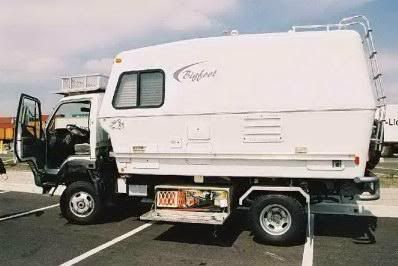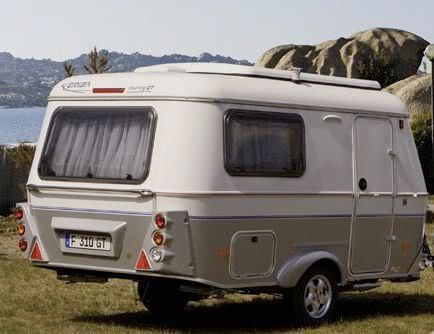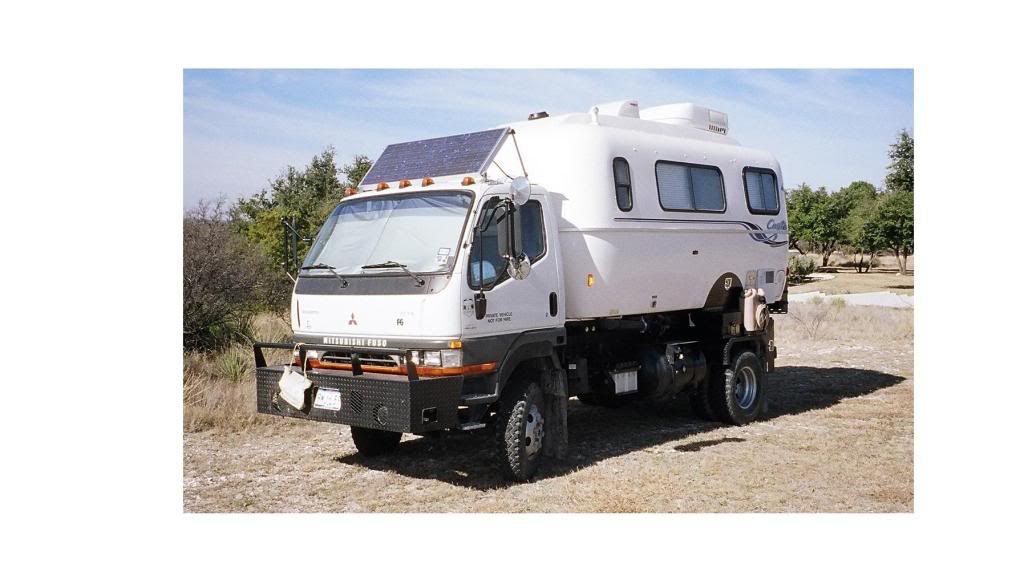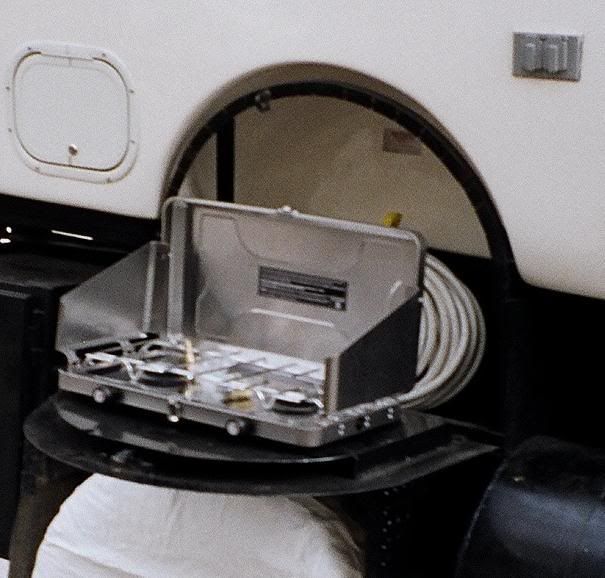While some may wish to build a custom "cabin" for their overland travel vehicle, others may wish to take a faster and (usually) cheaper approach: Modify a commercially-available travel trailer for use on the back of a 4x4 truck.
Here's a very successful example. Carl Hunter of Vancouver purchased a Bigfoot travel trailer, and configured it to fit on the back of a Fuso FG 4x4 medium truck.

The trailer started out as a 17 foot model, but after the trailer hitch was removed and the propane tanks relocated, the cabin is about 13 feet long.
The project took only 90 days to design and build. Carl and his wife, Mary, left home shortly thereafter, and used the Bigfoot-Fuso combination as their home on a 25,000 mile journey around the world in 2002. They had no problems with the vehicle.
The Bigfoot trailer is well suited to use as a cabin on an overland vehicle because of its fiberglass construction. The fiberglass is tough, and has enough resilience to resist cracking from the constant vibration caused by travel over rough roads. Because the trailer body is constructed from two large molded pieces (top and bottom), the number of seams is reduced. This makes water leaks less likely than with other types of construction. And fiberglass is cheap and easy to patch in the event of an accident.
Below is a list of manufacturers who make fiberglass travel trailers in North America today. Many of these designs are inspired by the Boler trailer, a Canadian design from the late 1960's.
Bigfoot 25R17 17 foot models
http://www.bigfootrv.com/bigfootrv_travel_trailers_2500.html
Oliver Travel Trailers
http://www.olivertraveltrailers.com
Escape Trailer Industries
http://www.escapetrailer.com
Casita Travel Trailers
http://www.casitatraveltrailers.com
Scamp Trailers
http://www.scamptrailers.com/
Burro Travel Trailers
http://www.burrotrailers.com
Team Trillium Trailers Manufacturing Ltd.
http://www.trilliumtrailers.com
Egg Camper
http://www.eggcamper.com
There were a good number of fiberglass trailer manufacturers in the 1970's and 80s that are no longer in business. Because of the durability of fiberglass, these trailers are still viable, even 30 years after they were built.
If you know of additional fiberglass travel trailers, please let me know.
Chip Haven
Here's a very successful example. Carl Hunter of Vancouver purchased a Bigfoot travel trailer, and configured it to fit on the back of a Fuso FG 4x4 medium truck.

The trailer started out as a 17 foot model, but after the trailer hitch was removed and the propane tanks relocated, the cabin is about 13 feet long.
The project took only 90 days to design and build. Carl and his wife, Mary, left home shortly thereafter, and used the Bigfoot-Fuso combination as their home on a 25,000 mile journey around the world in 2002. They had no problems with the vehicle.
The Bigfoot trailer is well suited to use as a cabin on an overland vehicle because of its fiberglass construction. The fiberglass is tough, and has enough resilience to resist cracking from the constant vibration caused by travel over rough roads. Because the trailer body is constructed from two large molded pieces (top and bottom), the number of seams is reduced. This makes water leaks less likely than with other types of construction. And fiberglass is cheap and easy to patch in the event of an accident.
Below is a list of manufacturers who make fiberglass travel trailers in North America today. Many of these designs are inspired by the Boler trailer, a Canadian design from the late 1960's.
Bigfoot 25R17 17 foot models
http://www.bigfootrv.com/bigfootrv_travel_trailers_2500.html
Oliver Travel Trailers
http://www.olivertraveltrailers.com
Escape Trailer Industries
http://www.escapetrailer.com
Casita Travel Trailers
http://www.casitatraveltrailers.com
Scamp Trailers
http://www.scamptrailers.com/
Burro Travel Trailers
http://www.burrotrailers.com
Team Trillium Trailers Manufacturing Ltd.
http://www.trilliumtrailers.com
Egg Camper
http://www.eggcamper.com
There were a good number of fiberglass trailer manufacturers in the 1970's and 80s that are no longer in business. Because of the durability of fiberglass, these trailers are still viable, even 30 years after they were built.
If you know of additional fiberglass travel trailers, please let me know.
Chip Haven




